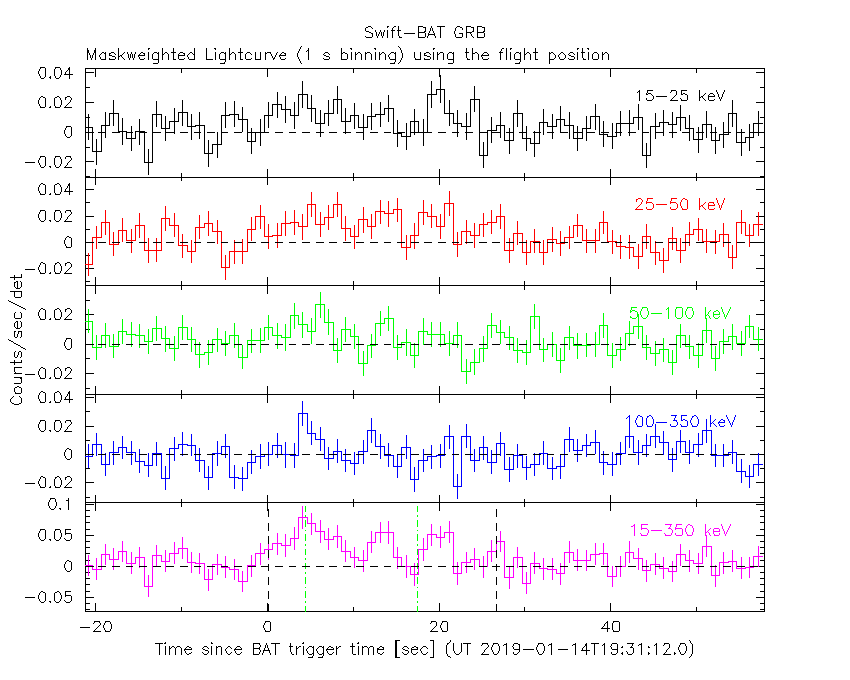
M.H. Siegel (PSU) and A. D'Ai (INAF-IASFPA) for the Swift team
At 19:31:12 UT, the Swift Burst Alert Telescope (BAT) triggered and located GRB 190114B (trigger=883818) (Siegel et al. GCN Circ. 23686). Swift slewed immediately to the burst. At the time of the trigger, the initial BAT position was 125° from the Sun (8.1 hours West) and 137° from the 55%-illuminated Moon. Table 1 contains the best reported positions from Swift, and the latest XRT position can be viewed at http://www.swift.ac.uk/xrt_positions.
Pozanenko et al. (GCN Circ. 23696) reported the position from Mondy for the optical afterglow of this GRB. Table 2 is a summary of GCN Circulars about this GRB from observatories other than Swift.
Standard analysis products for this burst are available at https://gcn.gsfc.nasa.gov/swift_gnd_ana.html.
As reported by Cummings et al. (GCN Circ. 23721),
the BAT ground-calculated position is RA, Dec = 174.868, 18.882 deg which is RA(J2000) = 1
The mask-weighted light curve (Figure 1) shows a weak pulse that starts at ~
The time-averaged spectrum from T-1.2 to T+27.9 s is best fit by a simple power-law model.
The power law index of the time-averaged spectrum is 1.98 ± 0.28.
The fluence in the 15-150 keV band is 5.1 ± 1.0 x 1
The results of the batgrbproduct analysis are available at https://gcn.gsfc.nasa.gov/notices_s/883818/BA/.
Analysis of the initial XRT data was reported by D'Ai et al. (GCN Circ. 23730). We have analysed 5.9 ks of XRT data for GRB 190114B, from 165 s to 173.9 ks after the BAT trigger. The data are entirely in Photon Counting (PC) mode. The enhanced XRT position for this burst was given by Goad et al. (GCN Circ. 23691).
The light curve (Figure 2) can be modelled with a power-law decay with a decay index of α=2.1 ± 0.4.
A spectrum formed from the PC mode data can be fitted with an absorbed power-law with a photon spectral index of 1.99 (+0.34, -0.14). The best-fitting absorption column is consistent with the Galactic value of 1.7 x 1
A summary of the PC-mode spectrum is thus:
Total column: 1.7 ± 4.8 x 1
Galactic foreground: 1.7 x 1
Excess significance: <1.6 σ
Photon index: 1.99 (+0.34, -0.14)
The results of the XRT team automatic analysis are available at http://www.swift.ac.uk/xrt_products/00883818.
The Swift/UVOT began settled observations of the field of GRB 190114B 158 s after the BAT trigger
(Siegel GCN Circ. 23720).
No optical afterglow consistent with the enhanced XRT position (Goad et al. GCN Circ. 23691) or the position of the faint optical counterpart (Fernandez-Garcia et al., GCN Circ. 23694; Pozanenko et al., GCN Circ. 23696, Selsing et al. GCN Circ. 23713) is detected in the initial UVOT exposures.
Table 3 gives preliminary
magnitudes using the UVOT photometric system
(Breeveld et al. 2011, AIP Conf. Proc., 1358, 373).
No correction has been made for the expected extinction in the Milky Way
corresponding to a reddening of

Figure 1. The BAT
mask-weighted light curve in the four individual and total
energy bands. The units are counts

Figure 2. The XRT light curve.
Any data from a crosshatched region are not included in the fit.
| RA (J2000) | Dec (J2000) | Error | Note | Reference |
|---|---|---|---|---|
| 1 |
+18°53'26.9" | 2.3" | XRT-final | UKSSDC |
| 1 |
+18°53'26.9" | 2.3" | XRT-enhanced | Goad et al. GCN Circ. 23691 |
| 1 |
+18°52'53.5" | 2.3' | BAT-refined | Cummings et al. GCN Circ. 23721 |
| Band | Authors | GCN Circ. | Subject | Observatory | Notes |
|---|---|---|---|---|---|
| Optical | Fernandez-Garcia et al. | 23694 | BOOTES-4/MET optical afterglow detection | BOOTES-4 | detection |
| Optical | Pozanenko et al. | 23696 | Mondy optical afterglow detection | Mondy | detection |
| Optical | Xin et al. | 23703 | GWAC-F60B upper limit | Xinglong Obs. | upper limits |
| Optical | Itoh et al. | 23705 | MITSuME Akeno optical upper limits | MITSuME Akeno | upper limits |
| Optical | Selsing et al. | 23713 | NOT optical counterpart | NOT | detection |
| Optical | Volnova et al. | 23722 | optical afterglow observations in Mondy and Abastumani observatories |
Abastumani | detection |
| Optical | Blazek et al. | 23723 | Liverpool Telescope near-IR observations | Liverpool Telescope | detection |
| Optical | Volnova et al. | 23743 | continued optical observations in Mondy | Mondy | marginal detection |
| Filter | Exp(s) | Mag | ||
|---|---|---|---|---|
| 158 | 408 | 246 | >20.2 | |
| v | 464 | 1976 | 175 | >18.5 |
| b | 414 | 2075 | 214 | >19.9 |
| u | 158 | 2050 | 568 | >20.4 |
| w1 | 513 | 2025 | 194 | >19.7 |
| m2 | 786 | 2000 | 117 | >18.9 |
| w2 | 440 | 2100 | 194 | >19.8 |
Table 3. UVOT observations reported by Siegel (GCN Circ. 23720). The start and stop times of the exposures are given in seconds since the BAT trigger. The preliminary 3-σ upper limits are given. No correction has been made for extinction in the Milky Way.
January 17, 2019